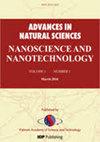Facile one-step synthesis of in situ WO3@Gr nanorods as an efficient material for antimicrobial and decoloration applications
IF 2.1
Q3 MATERIALS SCIENCE, MULTIDISCIPLINARY
Advances in Natural Sciences: Nanoscience and Nanotechnology
Pub Date : 2024-05-27
DOI:10.1088/2043-6262/ad4851
引用次数: 0
Abstract
This work examined the synthesis, antibacterial activity, and decolourisation of WO3@Graphene nanorods (WO3@Gr NR). WO3@Gr NR nanocomposite was in situ produced via a facile one-step hydrothermal process employing sodium tungstate dihydrate and exfoliated graphene as precursors. The resulted NR exhibited an average diameter of 13 nm, a large specific surface area of 53.3 m2 g−1, and a bimodal pore size distribution with an average pore size of 5.5 nm. The optical bandgap is extrapolated to be 2.75 eV. Graphene was shown to be responsible for the sample’s elaborate visible-light absorption, which improved adsorption and the ability to harvest visible light. WO3@Gr NR are more efficient against E. coli than S. aureus, killing up to 52% and 39% of cells, respectively, after two hours of treatment. When used in conjunction with invisible light, the NR killed E. coli and S. aureus by 78 and 62%, respectively. The bactericidal activity of photoinduced WO3@Gr NR was evaluated against P. aerugunosa, E. faecalis, E. coli, and S. aureus. The photocatalytic constant rates of organic dye methylene blue (MB) were determined to be 0.01 min−1. An IC50 (50% cell growth inhibition) value of 97 (μg ml−1) was determined for the nanocomposite against human liver cancer cell lines (HepG2). Our findings suggest that this nanorod may be utilised to degrade bacteria and organic colours in wastewater simultaneously while posing no risk to human health.一步法简便合成原位 WO3@Gr 纳米棒,作为抗菌和脱色应用的高效材料
这项研究考察了 WO3@石墨烯纳米棒(WO3@Gr NR)的合成、抗菌活性和脱色。WO3@Gr NR 纳米复合材料以二水钨酸钠和剥离石墨烯为前驱体,通过简单的一步水热法原位制备而成。所制得的 NR 平均直径为 13 nm,比表面积高达 53.3 m2 g-1,孔径呈双峰分布,平均孔径为 5.5 nm。光带隙推断为 2.75 eV。研究表明,石墨烯对样品的可见光吸收起了重要作用,从而提高了吸附和收集可见光的能力。与金黄色葡萄球菌相比,WO3@Gr NR 对大肠杆菌的杀灭效率更高,处理两小时后,对细胞的杀灭率分别高达 52% 和 39%。当与不可见光同时使用时,NR 对大肠杆菌和金黄色葡萄球菌的杀灭率分别为 78% 和 62%。评估了光诱导 WO3@Gr NR 对绿脓杆菌、粪大肠杆菌、大肠杆菌和金黄色葡萄球菌的杀菌活性。有机染料亚甲基蓝(MB)的光催化常数为 0.01 min-1。纳米复合材料对人肝癌细胞株(HepG2)的 IC50(50% 细胞生长抑制)值为 97 (μg ml-1)。我们的研究结果表明,这种纳米棒可以同时降解废水中的细菌和有机色素,而且不会对人体健康造成危害。
本文章由计算机程序翻译,如有差异,请以英文原文为准。
求助全文
约1分钟内获得全文
求助全文
来源期刊

Advances in Natural Sciences: Nanoscience and Nanotechnology
NANOSCIENCE & NANOTECHNOLOGYMATERIALS SCIE-MATERIALS SCIENCE, MULTIDISCIPLINARY
自引率
4.80%
发文量
0
 求助内容:
求助内容: 应助结果提醒方式:
应助结果提醒方式:


